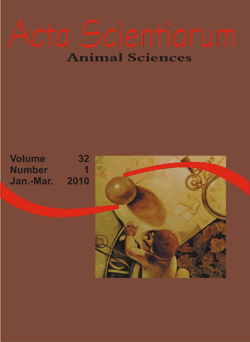<b>Chemical composition and dry matter total losses of soybean plant silage</b> - DOI: 10.4025/actascianimsci.v32i1.4897
Keywords:
reproductive stage, legume, nutritional value
Abstract
This trial was carried out to study the chemical composition and total DM losses of soybean silage at different reproductive stages. The work was divided in two evaluation periods: the 2005 and 2006 harvests. Four reproductive stages were determined (R3, R4, R5 and R6) as treatments in trial I (2005) and three reproductive stages (R5, R6 and R7) in trial II (2006). The material was conditioned in PVC experimental silos, and the samples were taken at the time the silo was opened (60 days after ensilage) to evaluate the chemical composition. In trial I, there were differences (p < 0.05) in the four reproductive stages for DM, ash, OM, CP, LIG, EE and BC. No differences were observed (p > 0.05) for NDF, ADF, NDIN, ADIN, CELL, total carbohydrate and pH. In trial II, the silages did not present differences (p > 0.05) for DM, ash, OM, CP, NDF, ADF, EE and total carbohydrate in function of the soybean harvest stage. The pH values, electric conductivity and buffering capacity of the silages were different (p < 0.05) among the reproductive stages. The advance of reproductive stage changes the nutritional value of whole-plant soybean silage. The water deficit adversely affects the suitable development of soybeans, where the protein value of silage is penalized.Downloads
Download data is not yet available.
Published
2009-12-16
How to Cite
Dias, F. J., Jobim, C. C., Soriani Filho, J. L., Bumbieris Junior, V. H., Poppi, E. C., & Santello, G. A. (2009). <b>Chemical composition and dry matter total losses of soybean plant silage</b> - DOI: 10.4025/actascianimsci.v32i1.4897. Acta Scientiarum. Animal Sciences, 32(1), 19-26. https://doi.org/10.4025/actascianimsci.v32i1.4897
Issue
Section
Pasture and forage utilization
DECLARATION OF ORIGINALITY AND COPYRIGHTS
- I Declare that current article is original and has not been submitted for publication, in part or in whole, to any other national or international journal.
The copyrights belong exclusively to the authors. Published content is licensed under Creative Commons Attribution 4.0 (CC BY 4.0) guidelines, which allows sharing (copy and distribution of the material in any medium or format) and adaptation (remix, transform, and build upon the material) for any purpose, even commercially, under the terms of attribution.
Read this link for further information on how to use CC BY 4.0 properly.
0.9
2019CiteScore
29th percentile
Powered by 








































